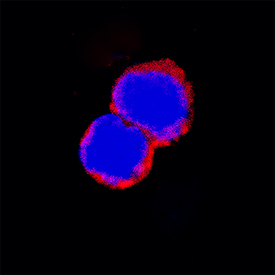Mouse Siglec-2/CD22 Antibody
R&D Systems, part of Bio-Techne | Catalog # AF2296

Key Product Details
Species Reactivity
Validated:
Cited:
Applications
Validated:
Cited:
Label
Antibody Source
Product Specifications
Immunogen
Ser22-Arg702
Accession # P35329
Specificity
Clonality
Host
Isotype
Endotoxin Level
Scientific Data Images for Mouse Siglec-2/CD22 Antibody
Cell Adhesion Mediated by Siglec‑2/CD22 and Neutral-ization by Mouse Siglec‑2/ CD22 Antibody.
Recombinant Mouse Siglec-2/ CD22 Fc Chimera (Catalog # 2296-SL), immobilized onto a microplate, supports the adhesion of human red blood cells in a dose-dependent manner (orange line). Adhesion elicited by Recombinant Mouse Siglec-2/ CD22 Fc Chimera (0.3 µg/mL) is neutralized (green line) by increasing concentrations of Goat Anti-Mouse Siglec-2/CD22 Antigen Affinity-purified Polyclonal Antibody (Catalog # AF2296). The ND50 is typically 0.1-0.5 µg/mL.Siglec‑2/CD22 in Mouse Splenocytes.
Siglec-2/CD22 was detected in immersion fixed mouse splenocytes using Goat Anti-Mouse Siglec-2/CD22 Antigen Affinity-purified Polyclonal Antibody (Catalog # AF2296) at 15 µg/mL for 3 hours at room temperature. Cells were stained using the NorthernLights™ 557-conjugated Anti-Goat IgG Secondary Antibody (red; Catalog # NL001) and counterstained with DAPI (blue). Specific staining was localized to cell surfaces. View our protocol for Fluorescent ICC Staining of Non-adherent Cells.Applications for Mouse Siglec-2/CD22 Antibody
Immunocytochemistry
Sample: Immersion fixed mouse splenocytes
Western Blot
Sample: Recombinant Mouse Siglec-2/CD22 Fc Chimera (Catalog # 2296-SL)
Neutralization
Formulation, Preparation, and Storage
Purification
Reconstitution
Formulation
Shipping
Stability & Storage
- 12 months from date of receipt, -20 to -70 °C as supplied.
- 1 month, 2 to 8 °C under sterile conditions after reconstitution.
- 6 months, -20 to -70 °C under sterile conditions after reconstitution.
Background: Siglec-2/CD22
Siglecs (sialic acid binding Ig-like lectins) are I-type (Ig-type) lectins belonging to the Ig superfamily. They are characterized by an N‑terminal Ig-like V-type domain which mediates sialic acid binding, followed by varying numbers of Ig-like C2-type domains (1, 2). Eleven human Siglecs have been cloned and characterized. Among these are sialoadhesin/CD169/Siglec-1, CD22/Siglec-2 and CD33/Siglec-3. To date, no Siglec has been shown to recognize any cell surface ligand other than sialic acid, suggesting that interactions with glycans containing this carbohydrate are important in mediating the biological functions of Siglecs. The cDNA of mouse Siglec-2 (also known as B-cell antigen CD22), encodes an 862 amino acid (aa) protein that contains a 21 aa signal peptide, a 681 aa extracellular region, a 19 aa transmembrane region and a 141 aa cytoplasmic tail (3, 4). The extracellular region contains one N-terminal V-type Ig-like domain followed by six Ig-like C2-type domains. The cytoplasmic domain has 3 immunoreceptor tyrosine-based inhibition motifs (ITIMs). Two splice forms exist, both showing deletions in the V-type Ig domain of 30 aa and 60 aa each. There are also two alleles in mouse that account for a difference of 10 aa in the extracellular region. The extracellular region of mouse Siglec-2 is 60% aa identity to human extracellular Siglec-2. Expression of mouse Siglec-2/CD22 generates a 140 kDa integral membrane glycoprotein that is limited to the B cell compartment of lymphoid tissues. Its expression is upregulated by LPS activtion (5, 6). Siglec-2/CD22 is an adhesion molecule that preferentially binds alpha2,6- linked sialic acid on the same (cis) or adjacent (trans) cells. Interaction of CD22 with trans ligands on opposing cells was found to be favored over the binding of ligands in cis (7).
References
- Nitschke, L. et al. (2001) Scand. J. Immunol. 53:227.
- Crocker, P.R. and A. Varki (2001) Immunology 103:137.
- Law, C-L. et al. (1993) J. Immunol. 151:175.
- Wienands, Y.J. et al. (1999) J. Biol. Chem. 274:18769.
- Wilson, G.L et al. (1991) J. Exp. Med. 173:137.
- Torres, P.M. (1992) J. Immunol. 194:2641.
- Collins, B.E. et al. (2004) Proc. Natl. Acad. Sci. 101:6104.
Long Name
Alternate Names
Gene Symbol
UniProt
Additional Siglec-2/CD22 Products
Product Documents for Mouse Siglec-2/CD22 Antibody
Product Specific Notices for Mouse Siglec-2/CD22 Antibody
For research use only

